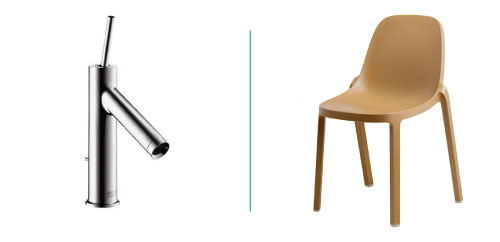Visiting Professor Brings Microscopy to Your Science (and Arts) Curriculum
The addition of core concepts related to engineering, technology, and applications of science to other areas of study, such as manufacturing, are the essence of the National Academy of Sciences’ crosscutting curriculum initiative. Using a crosscutting curriculum does not prioritize some knowledge over others, but rather harnesses the synergy that can be created when subjects like science and art come together.
As an example we can look to Philipe Starck, the famous French designer, and his design process used to create the Emeco Broom Chair. You are probably familiar with Starck’s work, he is a master at redesigning common everyday items and turning them into functional pieces of art. For example, his bathroom vanity faucet is probably one of the most copied, with knock-offs available at countless stores. When designing the Broom Chair, he describes his thinking and design process as a system or sphere, and that the object is nothing as compared to the system around it and the efforts required to make it. These efforts in this case are led by Starck, an artist, who employs knowledge workers from many STEM related fields to manufacture a well-designed and artistically beautiful chair.

Starck describes the process starting with “the worker in the woodshop who cuts wood all day, makes a lot of dust, and there is a guy with a broom who begins to clean up the dust in the workshop. He puts the wood dust into the garbage, but for the first time this wood does not go off to be burned, it goes off to Emeco (the manufacturer of the Broom Chair), where there are bags of other dust; from toys and old shoes, and many other things of plastic. You mix the dust of plastic, you mix the dust of wood, cook it, mold it, and you make this chair.” There are obviously many people involved in this process who play a number of roles, engineers, chemists, material scientists, but ultimately it comes back to Starck who is the “orchestra leader,” producing a product that is both artistically relevant and scientifically complex. In this system, Starck the artist appreciates all of the science that went into engineering a chair.
The microscope, like the ubiquitous chair, can be found in most professional laboratories. The microscope’s uses extend well beyond the biomedical sciences, and into a wide variety of disciplines, including chemistry, physics, materials analysis, forensic science, and quality control. Applying the microscope to these varied fields enhances our understanding of all things STEM and has been the essence of our microscopy professional development program for educators. In reality, most science teachers have enough knowledge to answer their students’ questions, but usually lack the tangible resources, especially when it comes to state-of-the art instrumentation. Many times this is where the exploration ends.
In an effort to help science teachers create a more “interesting and intriguing” science curriculum, we have developed a multifaceted microscopy program that helps achieve the light microscope’s fullest potential in the classroom. Hooke College of Applied Sciences has been visiting classrooms around the Chicagoland area with their scanning electron microscope for teachers and their students to use free of charge.
Our visiting professor has over 30 years of secondary education teaching experience and travels with a JEOL benchtop scanning electron microscope along with a light microscope and many interesting accessories. He arrives at your school prepared to deliver a presentation that can be customized to your needs. This program also provides a great opportunity for science teachers to invite their colleagues, including those from the art department, to view these demonstrations. How much fun is it to look at the complexity of paints and chalk at 60,000X magnification?
Comments
add comment